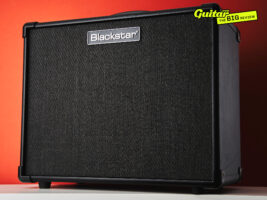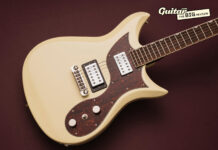
Blackstar ID:X 50 review: “stands out by knowing exactly what it is, and who it’s for”
£289, blackstaramps.com
Blackstar has been on an impressive hot streak over the last few years. From the impressive St James valve combos to the entry-level Debut amps, through to the content creator playground that is the ID:Core series, the brand has really hit the sweet spot between affordability, features and sound.
READ MORE: Boss Katana Gen 3 review: still the king of the modellers?
Now however, the brand is setting its sights firmly on the fertile ground occupied by the likes of Boss’s Katana range and Fender’s Mustangs – the no-nonsense gig-ready modelling combo. Watch out, the ID:X is coming for you…
Image: Adam Gasson
Blackstar ID:X 50 – what is it?
There are two flavours of the new ID:X combo arriving out of the gate – a 100-watt beast and this more bedroom-friendly 50-watter. The “ID” bit of the name does suggest some shared DNA with the hugely popular ID:Core series of course, and you can perhaps see this as the logical stepping stone for someone who bought one of those as their first amp.
So visually and in terms of the control panel things are pretty familiar on that front. For example, you have the same six onboard amp voicings as the ID:Core V3 – ranging from chiming cleans through to searing high gain. You also get a full three-band tone-stack here, in addition to Blackstar’s almost ubiquitous mid-mithering ISF control – a notable tone-shaping enhancement over its little brother.
You can’t very well take on the Katana without a bevvy of onboard effects, and you get plenty to get to grips with here. There are 34 distinct pre- and post-effects listed in the manual – everything from flavours of dirt to tremolo, phasers and even a shimmer delay – and Blackstar stresses this is a moveable feast, with more effects coming in the future.
Navigating all this comes courtesy of an onboard OLED screen – top marks for Blackstar not burying all this in a companion app as many would do in this era of smart amps. What you see is very much what you get.
In addition to the amps and effects you can also tweak the valve response options of each amp sound (between EL34, EL84 and 6L6 recreations), and this thing comes primed to gig with the ability to store up to 12 presets on board to ensure you don’t have to fiddle with that screen mid-song.
The player convenience features don’t end there either. You can drop the power down to 10 or even 1 watt for pure bedroom playing, while if you need to record things direct you have the convenience of Blackstar’s impressive CabRig technology, as well as a USB-C port for going digital direct.
There’s also a headphone output up top, and a line-in for putting your own songs or backing tracks through it, a built-in tuner and an effects loop. One thing that you won’t find however, is bluetooth audio – it’s strictly analogue here unfortunately.
Another slightly mystifying omission in the case of the 50 is a lack of a balanced XLR out – the 100-watt version has one, but if anything the 50 is more likely to need it in a gigging situation. It’s a little bit like forgetting to put wheels on a suitcase – you can live without it, sure, but it’s a hell of a lot easier if you have them.
Image: Adam Gasson
Blackstar ID:X 50 – usability and sounds
The reason that the Katanas of this world are so popular with ordinary guitarists is that they do a great job of getting out of the way. Blackstar has clearly been paying attention in that regard because getting to grips with the ID:X is as intuitive and simple as you could ever want it to be – with barely a glance at the manual I’m off to the races navigating the various sounds and effects, with the onboard controls being super easy to use and understand.
Plugging in and it’s immediately apparent that this is not the place to come if your stock in trade is whisper-thin jangly. The ID:X is a chin out, Saturday night rock machine. Regardless of what guitar I put it through, everything sounds thick, chewy, meaty… it’s an amp that begs to be played loudly and proudly.
That’s not to say it’s untamed or unruly however – the valve-like nature of these sounds had me feeling fully in control of how gnarly I wanted to get, breaking up naturally when I wanted it to, or providing a nice clean pedal platform if I needed it.
You can get a lot out of this amp without ever plugging it into a laptop, but it’s also worth noting that the real deep editing stuff is done via Blackstar’s excellent Architect software – and what an enjoyable experience that is. Despite the abundant options to tweak and refine here, you never feel like you need a PhD in music production to dial things in – it’s sleek, user-friendly and gets out of the way.
As I said, most of the parameters you’ll be tweaking day to day can be done easily on the amp itself, so the Architect is more of an occasional trip than a daily driver. That said, it would be nice to not have to plug into a laptop to do it. The lack of Bluetooth rears its ugly head again here I feel, but an iOS/Android app option would encourage you to get deep into the weeds more often.
That said, if I had to choose between one or the other, I’m glad they’ve gone down the wired connection route – the guitar world is littered with ill-conceived companion apps that barely work outside of laboratory conditions, and there’s something reassuring about just plugging a thing into another thing.
Image: Adam Gasson
Blackstar ID:X 50 – should I buy one?
There’s no shortage of impressive budget modelling amps out there, but too often these amps can end up falling down by trying too hard to be everything to everyone. The ID:X stands out by knowing exactly what it is, and who it’s for.
This is an excellent all-round rock machine that offers everything you’ll need to craft a wide variety of quality tones – but with the fundamental punch and girth of Blackstar at the forefront.
It’s not perfect, and if your stock in trade is exclusively jangly clean tones there are probably better options for you sonically. But for those chasing punchy high-gain tones with studio-ready flexibility and an interface that simply gets out of the way, this is a serious contender.
Image: Adam Gasson
Blackstar ID:X 50 – alternatives
If simplicity and sheer volume are your goals for a solid-state amp, then the no-messing and comically loud Orange O-Tone 40 ($399) is pretty hard to beat – it’s not versatile, but it’s as close to a ‘real’ amp as digital gets. The Fender Mustang LTX50 ($349) is another modelling amp that’s trying to keep the menu-diving to a minimum – and it does a nice job of it too. The king at this price point is of course the Boss Katana-50 Gen 3 ($349) – it also has the option of adding Bluetooth via an option dongle.
The post Blackstar ID:X 50 review: “stands out by knowing exactly what it is, and who it’s for” appeared first on Guitar.com | All Things Guitar.
Source: www.guitar-bass.net












